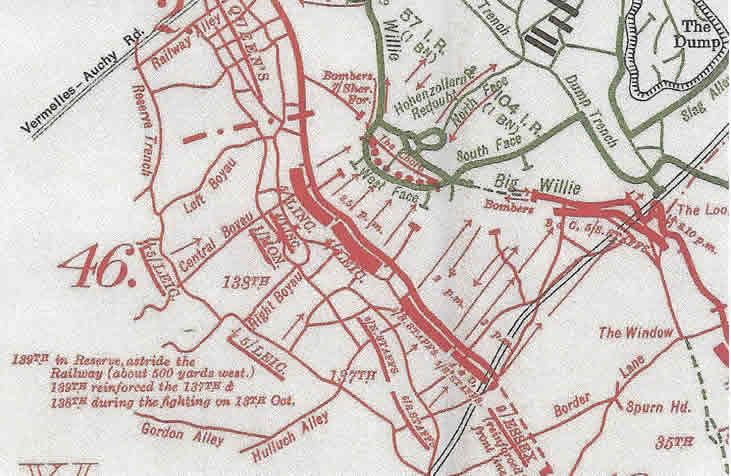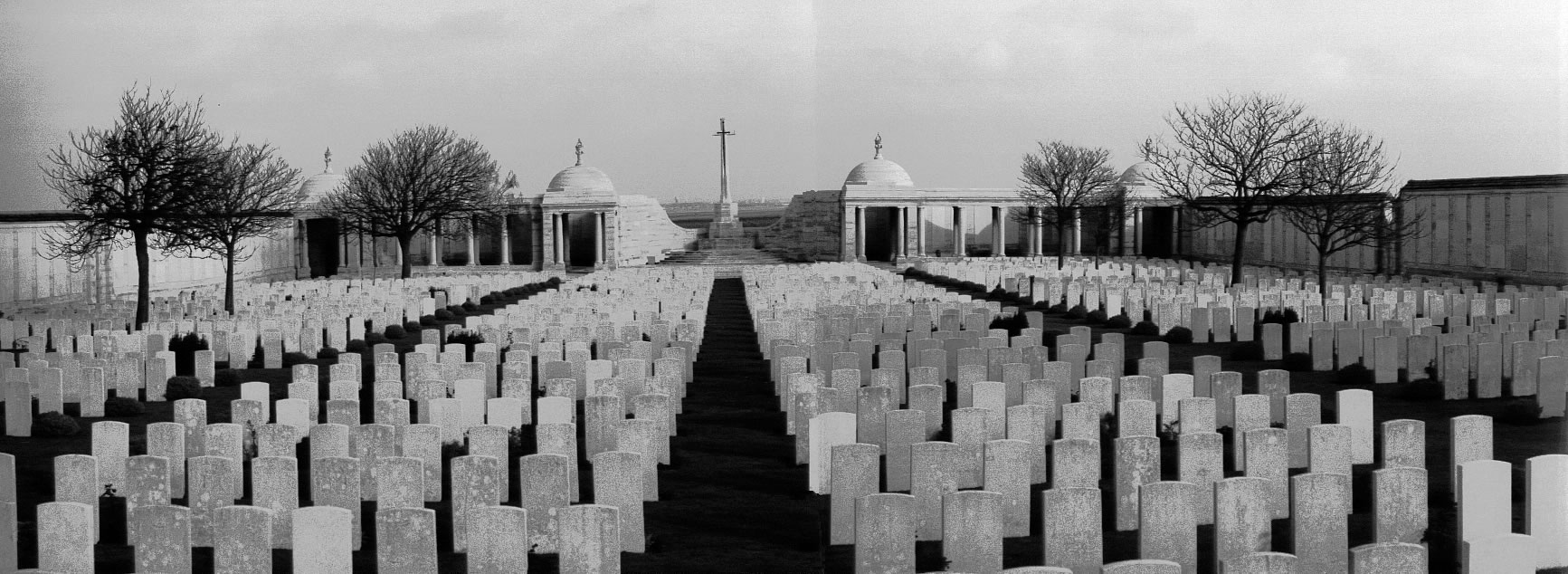|
|
The Hohenzollern Redoubt had been attacked and counter attacked for over a month before the Monmouthshires joined the assault. The redoubt is described by H.W.Wilson (The Great War) as a “masterpiece of fortification” The redoubt was a strongpoint some 500 yards in front of the German lines. It stood at the top of the gently rising ground and afforded a very wide field of fire.

Defended by an inordinate number of machine guns. They were so well placed as to be almost safe from shellfire, and so arranged that their bullets could converge all along the front and sweep their own trenches. The garrison shelter was 30 feet underground and beyond the penetration of the heaviest shells.
The following extract from the War Diary of 1st Mons gives some idea of the build up to the attack on the Redoubt. A long night march, through the narrow and overcrowded trenches to the battalions appointed destination, ready to form part of the attacking force on the 13th October 1915.
12 October 1915
Battalion paraded and marched with 138 Bde in the rear of 4th Lincolns starting at 2 p.m. via Hesdigneul Verquin to Sailly-Labours where Battalion arrived about 6 p.m. where tea was provided and rations issued. G.O.C. 46 Division saw Battalion march by at Sailly. Marched again at 8 p.m. to Brewery –Vermelles and there Battalion picked up R.E. Stores and water. Great number of troops on the road and some congestion. C.O. reported at Brigade H.Q. Communication trenches were very crowded and the Battalion did not reach the reserve trenches of the 2nd Battalion Irish Gds until 5.30 am.
A party of officers had reconnoitred the trenches the same day. A shell burst during the afternoon in this trench and killed 2/Lt G. Lewis and three men and wounded 4 others. Our guides were therefore short. The trenches occupied were very narrow and the men were very cramped. there being no shelter for them. Strength 17 Officers and 358 O Ranks.
13 October
The First Army front began a massive, two-hour, artillery barrage with 540 howitzers and other guns at 12.00 at 1.00 smoke and gas were released.
The Battalion was ordered to side slip to the left to make room for more troops, who were taken out of the front trenches in order to thin the line as gas was to be used. This necessitated moving the men again and making the still more cramped. This was done at 9.30 am. At 12 noon a heavy bombardment was started which lasted until 2 p.m. at which hour the assault was delivered. The 5th Lincs and the 4th Leicesters leading to be followed by the 4 Lincs and then the 1st Monmouths who were to consolidate the positions after secured. A and C Companies were ordered to lead out on the left and right respectively and their advance was most gallantly led and executed. Both Companies rushing to the assault from the support trench and passing over our trenches with great dash. Owing to the rapidity of their advance they both arrived in the Redoubt close behind the first two battalions and helped to secure it. The attached bombers followed, led by the C.O. and B & D Companies followed with the machine guns. There was much confusion in the Redoubt owing to the congestion of troops. the attack having been held up beyond. Immediate steps were taken to consolidate the western face of the redoubt while C and D companies held the eastern face. Guns were posted on the flanks and parties of bombers held off.
At 3pm the Germans counter attacked with bombs, but this attack was beaten off. There was an attempted retirement of troops but this was stopped at the western face and the ground held. At 5.30 another attack was delivered and another attempt at retirement of our troops which was partly arrested at the western face. A shortage of bombs made matters critical but the counter attack was again beaten off. Work of consolidation was proceeded with and the western face parapet reversed.
The night was very cold and the men were very fatigued indeed. A trench was dug in advance of the western face for observation purposes. The flanks of the redoubt could not be joined up owing to lack of working parties and a message was sent to the rear to this effect. Further supplies of bombs arrived but bombers were very scarce indeed. At 4 a.m. a heavy attack was made on both flanks by the enemy accompanied by rifle fire and rifle grenades. The position was very critical for some time , but the arrival of the 8th Sherwood Foresters on the right flank saved the situation, and the attack was beaten off.
At 6 a.m. the men who had had been in the redoubt for 24 hours were relieved and the command was handed over to the O/C. 5th Leicesters and the 1st Monmouths withdrew.
Taken from a letter published in the South Wales Argus 21.10.1915 from Colonel C.A.Evill to Col C.Smith (father of Lt L.Smith 1st Mons)
I regret having to write to tell you that your son was killed in action on the 13th inst, when we took part in an attack on the Hohenzollern Redoubt which was captured and subsequently held by us until consolidated. Your son died a noble death. The left part of the Redoubt was heavily attacked by the Germans after we had got to them with bombs and our supply had run out. It was during that time that your son was killed while rallying the men, Osey* was killed there and Jack Raikes* and Darby are missing.......... (* Major Oswald Williams was killed in action, Captain Raikes survived).
We were supposed to follow and consolidate the line, but we helped
to take it and afterwards held it all day and through the night until
relieved.............
We have lost officers, two killed, two missing and six wounded and I think
about 250 men.
These figures included Lt W.E.C.A. Darby and Pte 1315 A. Matthews 1st Mons. Neither man has a known grave and both are recorded on the Loos Memorial which commemorates over 20,000 officers and men who fell in the area who have no known grave.
Lieutenant William Edward Clere Augustus Darby, joined the 1st Battalion from the Oxford University Officer Training Corps on March 12th 1915, he was a student at Keble College. He had been educated at St Edmund’s School Canterbury.
An obituary written by his former Headmaster appeared in the school Book of Remembrance in July 1917. W.E.C.A. Darby was born May 6, 1893. Reported missing in France, subsequently reported killed, Oct. 13, 1915. He was the only child of the late Rev. J. C. S. Darby, Rector of Machen,. He entered the School in Sept, 1902, and left in July, 1913, and proceeded with a Watson-Wagner Scholarship to Keble College, Oxford, with the intention of preparing for Holy orders. During, his life here he rendered signal service to the School in manifold ways and was one of the best all-round athletes we have had. He was five years in the Ist XI in Football, and in his last year he was Captain of the School and Captain of all games. In 1913, the Ist XI won all their school matches in cricket, largely due to Darby's energy and efficiency. He was an excellent disciplinarian as Captain of the School and was always loyal. His letters always showed the deep affection he felt to the School. His eyesight was not perfect, but this difficulty was surmounted and he obtained a commission in the Monnouths and proceeded to France. The last letter I received from him was from Southampton on the eve of his departure while he was waiting to embark. He bore himself in battle as we should expect he would, but no news has ever been obtained as to how he met his death in the attack. The War Office has since informed his mother that he was killed sometime between Oct. 13 and Oct. 15.
In 1913 he represented his college 1st XI at both cricket and football and is commemorated on the college War Memorial. His name is also one of the 54 former pupils recorded on the St Edmund’s School memorial and he is further commemorated by private family memorial in St Johns Church, Machen.
‘To the glory of God and to the memory of those who fell, this Chapel has been extended and beautified’ (St Edmunds School)
‘Mementote alumnorum famulorum huius collegii
qui vindices liberates prodigi vitae pro patria animos reddiderunt’
(Remember the members and servants of this college who in defence of liberty
spared not their own lives and died for their country – Keble memorial)
William Darby and Alfred Matthews are commemorated at the Loos Memorial.


